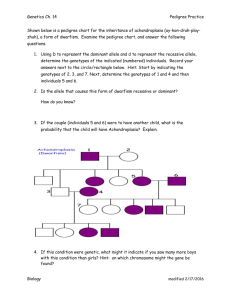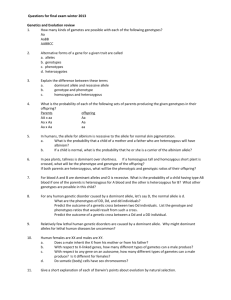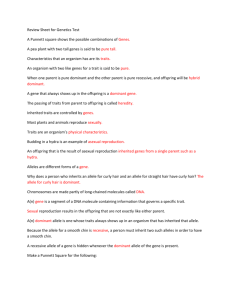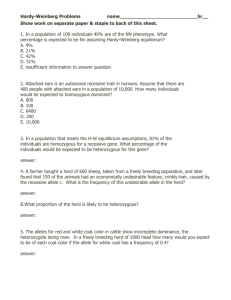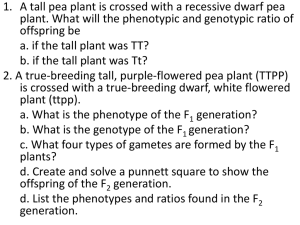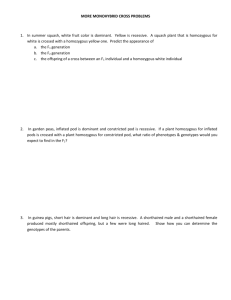MONOHYBRID CROSSES - Biology Note: in these problem sets, the
advertisement
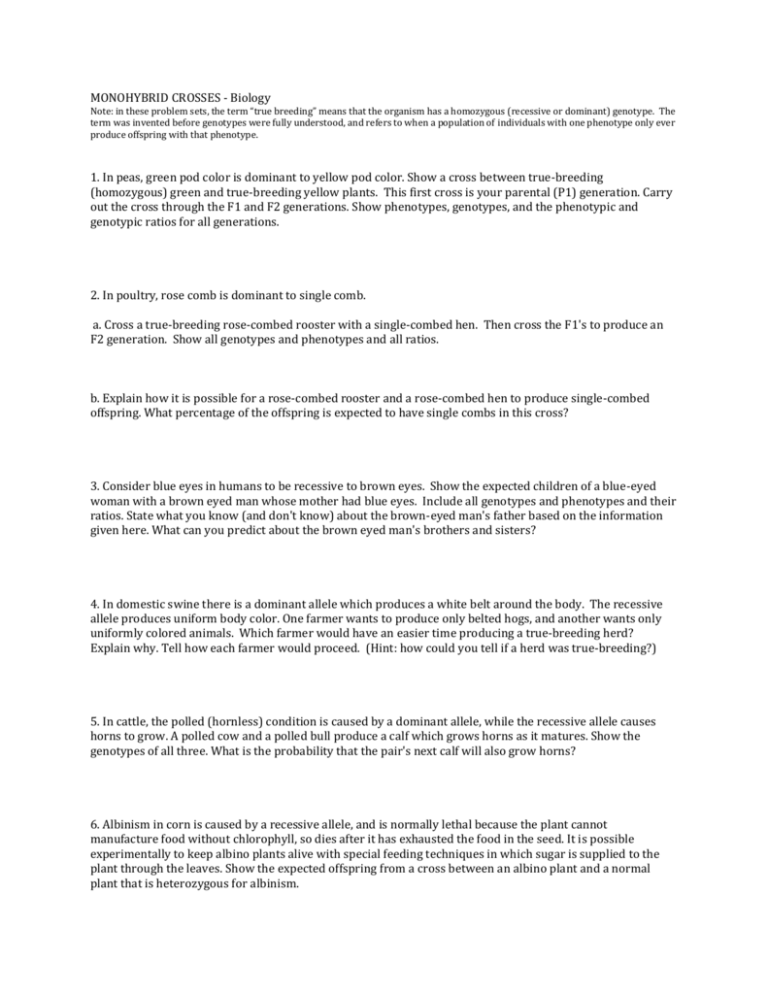
MONOHYBRID CROSSES - Biology Note: in these problem sets, the term “true breeding” means that the organism has a homozygous (recessive or dominant) genotype. The term was invented before genotypes were fully understood, and refers to when a population of individuals with one phenotype only ever produce offspring with that phenotype. 1. In peas, green pod color is dominant to yellow pod color. Show a cross between true-breeding (homozygous) green and true-breeding yellow plants. This first cross is your parental (P1) generation. Carry out the cross through the F1 and F2 generations. Show phenotypes, genotypes, and the phenotypic and genotypic ratios for all generations. 2. In poultry, rose comb is dominant to single comb. a. Cross a true-breeding rose-combed rooster with a single-combed hen. Then cross the F1's to produce an F2 generation. Show all genotypes and phenotypes and all ratios. b. Explain how it is possible for a rose-combed rooster and a rose-combed hen to produce single-combed offspring. What percentage of the offspring is expected to have single combs in this cross? 3. Consider blue eyes in humans to be recessive to brown eyes. Show the expected children of a blue-eyed woman with a brown eyed man whose mother had blue eyes. Include all genotypes and phenotypes and their ratios. State what you know (and don't know) about the brown-eyed man's father based on the information given here. What can you predict about the brown eyed man's brothers and sisters? 4. In domestic swine there is a dominant allele which produces a white belt around the body. The recessive allele produces uniform body color. One farmer wants to produce only belted hogs, and another wants only uniformly colored animals. Which farmer would have an easier time producing a true-breeding herd? Explain why. Tell how each farmer would proceed. (Hint: how could you tell if a herd was true-breeding?) 5. In cattle, the polled (hornless) condition is caused by a dominant allele, while the recessive allele causes horns to grow. A polled cow and a polled bull produce a calf which grows horns as it matures. Show the genotypes of all three. What is the probability that the pair's next calf will also grow horns? 6. Albinism in corn is caused by a recessive allele, and is normally lethal because the plant cannot manufacture food without chlorophyll, so dies after it has exhausted the food in the seed. It is possible experimentally to keep albino plants alive with special feeding techniques in which sugar is supplied to the plant through the leaves. Show the expected offspring from a cross between an albino plant and a normal plant that is heterozygous for albinism. 7. In Holstein cattle, spotting of the coat is caused by a recessive allele and solid coat color by a dominant allele. What types of offspring can occur in a cross between two spotted animals? 8. A woman has a rare eyelid abnormality called ptosis, which makes it impossible for her to open her eyes all the way. The condition is caused by a single dominant allele. The woman's father had ptosis but her mother was normal. Her father's mother also had normal eyelids. a. What are the genotypes of each of the people mentioned above? b. What proportion of her children would be expected to have ptosis if she marries a man with normal eyelids? 9. In humans there is a gene called sickle-cell anemia which produces severe anemia when homozygous. The name of the disease comes from the fact that many of the red blood cells take on an abnormal sickle shape. People homozygous for this trait usually die before adulthood. Heterozygous people appear normal, but when a sample of the blood is held under low oxygen concentration, the red cells take on the sickle shape. A young woman about to be married is concerned about her future children because her brother died of sicklecell anemia. A sample of her blood sickles under low oxygen concentration, but that of her perspective husband remains normal. What can you say about the man and the women, and about their future children?
